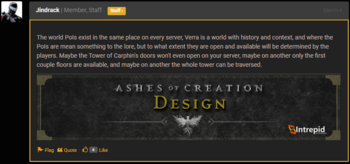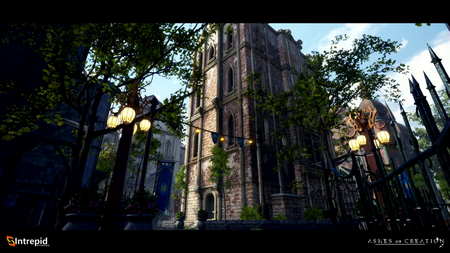Difference between revisions of "Node layout and style"
m (Text replacement - "{{Unique node building}}" to "{{Unique node buildings}}") |
(Add section) |
||
| Line 8: | Line 8: | ||
{{Node buildings}} | {{Node buildings}} | ||
| + | |||
| + | === Constructible node buildings === | ||
| + | |||
| + | {{Constructibles}} | ||
=== Unique node buildings === | === Unique node buildings === | ||
Revision as of 05:49, 10 July 2020
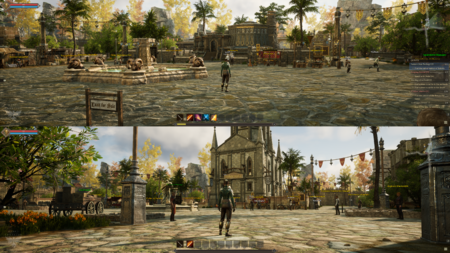
The layout and architecture within a Node’s development area are determined by influential race. For example, a stage 3 Node with the majority of player contribution being Py'rai would have a Py'rai village with Py'rai architecture. Most NPCs would be Py'rai elves, and offer questlines within the Py'rai narrative.[1] – Margaret Krohn
Each player’s contributed experience is flagged with their character race and other identifiers. When a Node advances, the race with the highest experience contribution determines the Node’s style and culture. This style and culture change can happen at every Node Stage. For example, if a Node advances to Level 2 - Encampment Stage and 51% of all experience was earned by Ren’Kai players, the Node will be a Level 2 Ren’Kai Node. If that same Node advances to a Level 3 - Village Stage Node, but the Py'Rai contributed 62% of all the experience earned, then the Node will be a Level 3 Py'Rai Node.[2] – Margaret Krohn
Node layout and style is determined by several factors:[3][4]
- The way that the node system is built is that they can exist across a spread of 18 biomes, but at the same time have to represent the cultural influence of these cultures that are intrinsically a part of a specific biome.[5] – Steven Sharif
- Environment (biome) and location of the node.[5][3][4]
- Nodes will adjust the local topography to fit the aesthetic and mechanical requirements of the node.[6]
- Currently the way that the platform system is set up, is it's capable of adjusting the topography of the node's footprint, regardless of the surrounding terrain. So the reason for that is we want to have flexibility in the presentation of the node's layout and how it is essentially both from an aesthetic standpoint as well as a mechanical standpoint with node sieges- how it's constructed and that construction should have the ability to take on a variance of different types of topography. So it shouldn't be dependent on the surrounding area. Now that's not to say that the surrounding area isn't going to have some influence over. So for example... we're experimenting a little bit with the platform tech and putting up a node up against the side of a mountain or on the edge of a cliff or something that has a beautiful vista. Those are things that we're going to test out obviously as we continue to work on the node tool and how that platform system works, but the idea is to have the node independent of the surrounding terrain.[6] – Steven Sharif
- Some parts are determined by the area it's in. Some parts are determined by the type it is. Some parts are determined by the race it is; and then the rest of it is determined by the mayor.[4] – Jeffrey Bard
- Race that contributed the highest percentage to the node's advancement will alter the racial appearance of its buildings, NPCs, and props.[7][8][3][2][4][9][10]
- All nodes, whether they're associated with a castle or associated with normal node structure, has cultural influences that replicate over to the buildings that are produced and the NPCs that are present.[12] – Steven Sharif
- The rest is determined by the node's mayor.[4]
- It should be possible for a node to complete several building projects within a mayor's one month term in office.[13]
- Q: How long would you say it will take players on average to fill/build up a node completely from wilderness to metropolis?
- A: It's one thing to get a node to a certain level: it's another thing to develop the node; and I can't really give you an on-average expectation, because there's a lot of variables at play. There's how many citizens does the node have attracted to it; what's the type of traffic that the node is attracting to it based on things like its tax rates, or the specialization that it chose to spec into, based on the building types it's chosen to build. All of those things are variables that can affect the quote-unquote "average build-out time" of a particular node. So it's difficult to give you an average when there's so many variables along those lines. But the idea is that if there is a particular project that players are interested in in developing based on the node stage, that they would have the ability to complete several of those projects as within a single term of a mayor; and a term of a mayor is one month.[13] – Steven Sharif
Taxation
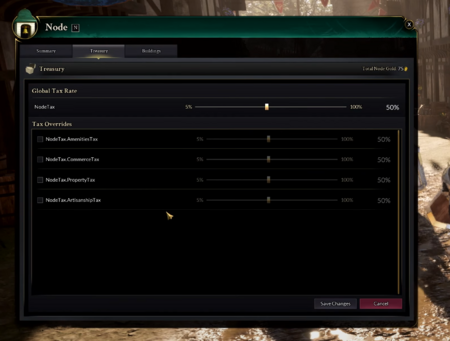
As the node levels up, you're gonna get access to deeper controls on the taxes, so that you as a Mayor can incentivize players to come to your node to do certain things. If you're a node that loves smithing, you're probably going to want to lower your taxes on artisanship to incentivize players to be here. But then you might want to drive up taxes on other avenues that players aren't necessarily coming to your node for, but are using out of convenience.[14] – Chris Justo
Mayors are able to set a generalized node tax rate as well as overrides for different activities within their node. Mayors gain additional taxation controls as their node advances.[14][15]
- Amenities tax override.[14]
- Artisanship tax override.[14]
- Commerce tax override.[14]
- This may include taxes that apply to tavern games.[16][17]
- Property tax override.[14]
- Freehold property taxes scale according to the number of freehold building permits issued for that freehold.[18][19][20]
- Citizenship dues and property taxes scale based on the stage of the node when a player became a citizen.[21][22][23][24][25]
- The goal is to exert financial pressure on node populations by making taxes increasingly expensive as nodes advance, rather than putting in place hard population caps.[23][24]
- Node tax rates will be visible on the world map by hovering over a node location.[26]
- Tax revenue only goes toward funding node development. This cannot be withdrawn by the mayor or any other player.[27][20]
Regent nodes take a cut of taxes from various activities that occur within their vassal node structure.[27][28]
- This tax doesn't necessarily impact the individual citizen, because citizen's tax levels are determined by their node, but the node's finances are affected by the taxation levied by its parent nodes.[28]
Node buildings
Constructible node buildings

The important thing with the service building system for us is that it's a way to shape your node like a character; and to give you an exclusive niche that you can carve out in the world; or a niche that you fight over. If you go down this weaponsmithing path and you build your node to be this mecca of weaponsmithing and the node three doors down builds it, there's reason for you to conflict over it. They're taking your business. Or maybe you are in a zone and there isn't a weaponsmithing thing anywhere near you, and you do want to start to carve that path for yourself to make your node a place people visit and come to.[29] – Chris Justo
Service buildings within a node are either default buildings that come with the node, or they are constructed buildings, which are initiated by the mayor and built by players.[21][29][30][31][32][33][34] Service buildings are further broken down into two main types:[21][29]
- Active service buildings are service buildings that players directly interact with. These are further broken down into Artisanship, Business, Content, and Political categories.[21][29]
- Passive service buildings provide passive benefits to the node or its zone of influence. These buildings are broken down into Civic, Cultural, Fabrication, Scholarly, and Vocational.[21][29]
- Constructed service buildings are available to every type of node in every location. Where the uniqueness comes in is in some of the default buildings like your node-type building.[35] – Chris Justo
Service buildings are upgraded by expansions, which are unlocked through the placement of passive service buildings.[21][29]
- Building expansions unlock higher tier workstations at the cost of dedicating service building plots.[36][32]
- Node service building expansions specialize the building through a tech tree based on the stage of the node.[37][38]
Service buildings incur a regular maintenance cost of node commodities and gold from the node treasury in order to continue operations.[21][39]
Unique node buildings
Each node type has a unique service building associated with it that can be activated at Village (stage 3) of node advancement.[35] The unique building plays a central role in the progress of civilization for a server.[41]
Racial quests
Quests may be based on a character's race.[42]
Different quests may relate to who the primary cultural contributor is to a node. This won't lock out content, but will add flavor to the quests.[42]
There might even be different directories of the quest that exist for specific races, and even though you're sharing a quest to kill a boss, if you're human and I'm an elf, I will have a different arc potentially that leads in a different direction than you, even though we took the same quest; and this can relate to who the primary cultural contributor is to a node unlocking different arcs for cultures that share the primary culture of a node - not that locks out content but it gives a flavor in a different direction so that not everything is so cookie cutter.[42] – Steven Sharif
Race matters because narratives have paths that also are influenced based on the primary contributing culture to the node... If you're a Niküa and you have you're in a Niküa node that's predominantly Niküa, you're going to have certain services and/or abilities as a member of the Niküa race that other races may not have access to... They may have alternative quest lines, but they won't have specific ones. Now those specific Niküa quests will then relate to the meta-narrative that's present in the world and they'll start to direct some of that meta-narrative; and that'll be beneficial for your kind because it will unlock certain content for your race that other races haven't unlocked yet. So there is an incentive there to see progression along that line now in order to curb the progress of a dominant race.[43] – Steven Sharif
Quests that are race specific, title specific, or guild specific will likely be less than 10% of the total number of quests. 90% of quests should be able to be shared by everybody.[44]
Node redevelopment
A node that was successfully destroyed by a node siege may develop differently due to the following influences:[3][45]
- Different races becoming primary contributors.[3][45]
- Design elements determined by different governments.[3][45]
- Reactions and interactions with other nodes in the world.[3][45]
Adaptive content
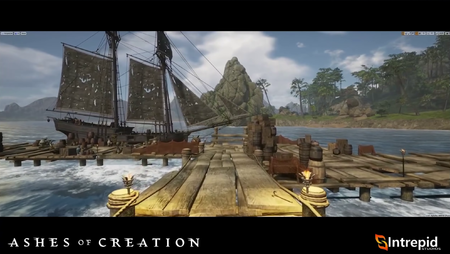
This is actually a dynamic POI. This one will evolve as players evolve the node that it's attached to. So this is its final state.[46] – Jeffrey Bard
New points of interest (such as dungeons, world bosses, and corrupted areas) spawn as nodes develop.[47][48] This content adapts to the node progression of the zone it is in.[46][49]
- Additional buildings will spawn.[46]
- Additional mobs will spawn.[46]
- Different antagonists/leaders with different story lines.[46][49]
- Populations will change.[49]
- Content difficulty will change.[49]
- The content may be different altogether.[49]
- Additional quest hooks.[46]
- Dungeons will be unlocked when certain nodes advance to certain stages.[50]
- Drop tables in areas and dungeons will be tied into the progression of certain areas.[50]
- POI events are events that relate to specific points-of-interest (POI).[54]
- The location of points of interest will be the same on each server, but some servers may have limited or no access to them.[55]
- Certain dungeons and other points of interest across the map will all be affected by the server’s node development. Some dungeons will only be unlocked if nodes are developed to certain stages. The storyline objectives for players inside dungeons will also be dependent on the story arc paths chosen through the node system. The drop tables in area and dungeons will also be tied into the progression of certain areas. For example, let’s say that the humans have developed a node in Region A, and a storyline has opened up that leads players to inspect the ruins (dungeon) of a nearby area. And let’s say that this node was developed in a scientific (crafting) zone… Well before the node developed, this dungeon was accessible… But now the dungeon has propagated new monster assets that include a drop table catering to a crafting emphasis because of the development of that academic node. And perhaps, a new boss appears in different rooms of the dungeon that includes different adventure quest starts, like a mysterious item with a storyline that can only be progressed if a node develops to the metropolis stage in a certain region, across the world. Our system is so vast, when it comes to interconnectivity and how the world reacts to the players.[50]
See also
References
- ↑ Blog - Know Your Nodes - The Basics.
- ↑ 2.0 2.1 2.2 Blog - Know Your Nodes - Advance and Destroy.
- ↑ 3.0 3.1 3.2 3.3 3.4 3.5 3.6 Livestream, October 30, 2020 (39:17).
- ↑ 4.0 4.1 4.2 4.3 4.4 4.5 Livestream, September 27, 2018 (53:06).
- ↑ 5.0 5.1 Livestream, February 25, 2022 (41:00).
- ↑ 6.0 6.1 Livestream, February 26, 2021 (1:12:18).
- ↑ Livestream, March 31, 2022 (4:57).
- ↑ Podcast, April 11, 2021 (29:47).
- ↑ Interview, May 11, 2018 (54:34).
- ↑ Livestream, May 26, 2017 (21:23).
- ↑ Podcast, April 11, 2021 (23:36).
- ↑ 12.0 12.1 Interview, May 11, 2018 (47:27).
- ↑ 13.0 13.1 Livestream, July 29, 2022 (1:13:09).
- ↑ 14.0 14.1 14.2 14.3 14.4 14.5 14.6 14.7 Video, August 31, 2023 (28:04).
- ↑ Livestream, March 28, 2020 (1:03:38).
- ↑

- ↑

- ↑ Interview, July 9, 2023 (54:46).
- ↑ Livestream, June 30, 2023 (1:45:22).
- ↑ 20.0 20.1

- ↑ 21.0 21.1 21.2 21.3 21.4 21.5 21.6 21.7 Blog: Development Update with Village Node.
- ↑ Livestream, August 31, 2023 (15:51).
- ↑ 23.0 23.1 Interview, July 9, 2023 (38:14).
- ↑ 24.0 24.1 Interview, March 27, 2020 (0:30).
- ↑ Video, April 5, 2018 (41:48).
- ↑ Livestream, September 29, 2023 (1:11:22).
- ↑ 27.0 27.1 Livestream, August 26, 2022 (1:10:16).
- ↑ 28.0 28.1 Interview, May 11, 2018 (57:02).
- ↑ 29.0 29.1 29.2 29.3 29.4 29.5 29.6 Livestream, August 31, 2023 (50:25).
- ↑ Video, August 31, 2023 (2:59).
- ↑ Interview, July 9, 2023 (1:32:45).
- ↑ 32.0 32.1 Livestream, May 19, 2017 (33:57).
- ↑ Livestream, January 20, 2018 (38:17).
- ↑ Livestream, 2018-04-8 (PM) (51:49).
- ↑ 35.0 35.1 Livestream, August 31, 2023 (56:18).
- ↑ Livestream, August 31, 2023 (52:56).
- ↑ Video, August 31, 2023 (34:37).
- ↑ Livestream, March 31, 2022 (1:13:00).
- ↑ Livestream, August 31, 2023 (57:23).
- ↑ Livestream, September 1, 2018 (36:28).
- ↑ Know Your Nodes: Economic Node Type.
- ↑ 42.0 42.1 42.2 Podcast, April 23, 2018 (29:56).
- ↑ Interview, May 11, 2018 (1:00:19).
- ↑ Livestream, July 26, 2019 (1:13:23).
- ↑ 45.0 45.1 45.2 45.3 Livestream, May 24, 2017 (52:39).
- ↑ 46.0 46.1 46.2 46.3 46.4 46.5 46.6 Livestream, March 26, 2021 (50:33).
- ↑ Livestream, March 26, 2021 (22:53).
- ↑ Livestream, November 17, 2017 (36:22).
- ↑ 49.0 49.1 49.2 49.3 49.4 Livestream, November 17, 2017 (18:29).
- ↑ 50.0 50.1 50.2 50.3 MMOGames interview, January 2017
- ↑

- ↑

- ↑ Livestream, July 25, 2020 (46:08).
- ↑ Livestream, April 29, 2022 (40:21).
- ↑
